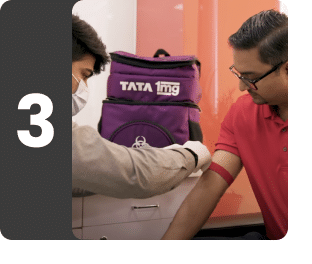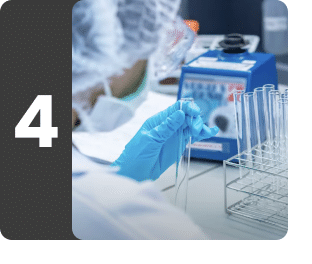Extractable Nuclear Antigens (ENA), Quantitative Profile
Understanding Extractable Nuclear Antigens (ENA), Quantitative Profile
What is Extractable Nuclear Antigens (ENA), Quantitative Profile?
The Extractable Nuclear Antigens (ENA), Quantitative Profile detects the presence of specific antibodies in the blood that attack healthy parts of the body's cells. This test helps doctors diagnose autoimmune diseases like systemic sclerosis, lupus (SLE), rheumatoid arthritis (RA), Sjogren’s syndrome, dermatomyositis, and other mixed connective tissue disorders.
ENA (Extractable Nuclear Antigens) are proteins found in the nucleus of cells that can trigger an autoimmune response. The Extractable Nuclear Antigens (ENA), Quantitative Profile helps diagnose various autoimmune diseases, including systemic lupus erythematosus (SLE), Sjogren's syndrome, rheumatoid arthritis (RA), scleroderma, and other mixed connective tissue disorders.
This test confirms the presence of autoantibodies that target specific nuclear antigens. It looks at a set of antigens, including those related to extractable nuclear antigens (ENA), which are key indicators of autoimmune diseases. By identifying certain antigens linked to different autoimmune disorders, the Extractable Nuclear Antigens (ENA), Quantitative Profile helps doctors understand and classify the type of autoimmune response happening in an individual’s body.
The Extractable Nuclear Antigens (ENA), Quantitative Profile is typically suggested when a doctor suspects an autoimmune disorder due to symptoms such as joint pain, fatigue, skin rashes, light sensitivity, or inflammation. Also, it may be advised if there are risk factors, such as a family history of autoimmune diseases. Additionally, it can be done if other laboratory tests or clinical findings suggest an autoimmune cause for the symptoms. The Extractable Nuclear Antigens (ENA), Quantitative Profile is also useful for monitoring disease activity and treatment response in patients already diagnosed with autoimmune diseases. Overall, recommending Extractable Nuclear Antigens (ENA), Quantitative Profile is based on the patient’s clinical presentation, medical history, and the doctor’s discretion in ruling out other potential causes of symptoms.
No special preparation is required for this test. Inform the doctor about any medications or supplements being taken, as they may affect the test results. Additionally, telling a detailed medical history and discussing symptoms can help the doctor correlate the clinical and laboratory findings.
The test results may vary depending on various factors like age, medical history, and certain risk factors, among others. Abnormal test results require an expert interpretation. Therefore, never self-medicate at home based solely on these results. Always consult a doctor to understand the test results correctly. The insights from this test help the doctor tailor appropriate treatment plans.
Please note: This is an outsourced test. The sample for this test is collected by TATA 1MG and processed at a NABL accredited partnered lab.
What is Extractable Nuclear Antigens (ENA), Quantitative Profile used for?
The Extractable Nuclear Antigens (ENA), Quantitative Profile is done:
- To identify and distinguish between autoimmune diseases like lupus, Sjögren’s syndrome, scleroderma, and polymyositis.
- To confirm a diagnosis in individuals showing symptoms like joint pain, skin changes, dry eyes or mouth, or muscle weakness.
- To assess the risk in individuals with a family history of autoimmune diseases.
- To help plan better treatment for autoimmune conditions and make interventions more effective.
- To track how autoimmune disorders are progressing and see how well treatments are working over time.
What does Extractable Nuclear Antigens (ENA), Quantitative Profile measure?
Contains 7 testsThe Extractable Nuclear Antigens (ENA), Quantitative Profile measures various autoantibodies that target extractable nuclear antigens, which helps in identifying specific autoimmune diseases. This test includes a panel that checks for several antibodies, such as the SCL-70 antibody, which is associated with systemic sclerosis, and Anti-SS-A and Anti-SS-B antibodies, which are linked to Sjögren's syndrome and systemic lupus erythematosus (SLE). It also tests for the Jo-1 antibody, related to polymyositis; the Sm antibody, which is connected to SLE; the Centromere antibody for CREST syndrome; and U1-SnRNP for mixed connective tissue disease. Together, these tests offer a comprehensive evaluation of autoimmune activity. They enable clinicians to understand immune mechanisms and tailor appropriate therapeutic interventions.

SCL-70 Antibody, Serum
The SCL-70 Antibody, Serum test detects the presence of antibodies against the topoisomerase I enzyme, which plays a role in DNA replication and repair. The presence of these antibodies are associated with systemic sclerosis (SSc), also known as scleroderma. The test can help diagnose SSc, predict the risk of complications, and differentiate SSc from other similar autoimmune conditions. A positive test result suggests that the immune system may be attacking this enzyme, which can lead to tissue damage and fibrosis. A negative result typically means that these antibodies are not present, making systemic sclerosis less likely, though it doesn’t completely rule it out. Additional tests may be needed to confirm a diagnosis or explore other possible autoimmune conditions.
Know more about SCL-70 Antibody, Serum

Anti SS-A Antibody
The Anti SS-A Antibody test also known as the Anti-Ro antibody test, detects antibodies against the SS-A (Ro) antigen, which is commonly linked to autoimmune diseases such as systemic lupus erythematosus (SLE), Sjögren's syndrome, and other connective tissue disorders. A positive result can indicate an increased risk of developing these conditions and is especially useful in diagnosing Sjögren’s syndrome. It also helps assess the risk of complications like neonatal lupus or congenital heart block in infants born to mothers with anti-SS-A antibodies. While a negative result generally suggests these conditions are less likely but does not completely rule them out as some individuals with these autoimmune conditions may not have detectable Anti SS-A antibodies.
Know more about Anti SS-A Antibody

Anti SS-B Antibody
The Anti SS-B Antibody also known as the Anti-La antibody test, detects antibodies against the SS-B (La) antigen, which is often associated with autoimmune diseases like systemic lupus erythematosus (SLE), Sjögren's syndrome, and other connective tissue disorders. A positive result can suggest an increased risk for these conditions, particularly Sjögren’s syndrome, and may also be linked to complications such as neonatal lupus and congenital heart block in infants born to mothers with anti-SS-B antibodies. While a negative result generally indicates these conditions are less likely, it does not completely rule them out, as some individuals with these autoimmune diseases may not test positive for Anti SS-B antibodies.
Know more about Anti SS-B Antibody

Jo-1 Antibody Serum, EIA
The Jo-1 Antibody Serum, EIA test is used to detect the presence of Jo-1 antibodies in the blood, which are most commonly associated with polymyositis and dermatomyositis, two types of autoimmune inflammatory muscle diseases. These antibodies target a specific protein involved in protein synthesis within cells. A positive Jo-1 antibody test can help confirm the diagnosis of these conditions and may also indicate an increased risk for complications, such as interstitial lung disease, which often occurs alongside these diseases. While a negative result typically suggests that these conditions are less likely, it doesn't rule them out entirely. Additional tests may be needed to confirm a diagnosis or explore other possible autoimmune conditions.
Know more about Jo-1 Antibody Serum, EIA

Sm Antibody Smith Antibody Serum
The Sm Antibody Smith Antibody Serum test detects the presence of antibodies against the Smith antigen, a protein found in the nucleus of cells. These antibodies are most commonly associated with systemic lupus erythematosus (SLE), an autoimmune disease where the immune system attacks healthy tissues. A positive result for Sm antibodies is highly specific for SLE and can help confirm the diagnosis, especially when combined with other clinical findings. A negative result does not rule out lupus entirely, as some people with SLE may not have these antibodies. Additional tests may be needed to confirm a diagnosis or explore other possible autoimmune conditions.
Know more about Sm Antibody Smith Antibody Serum

Centromere Antibody, IgG
The Centromere Antibody, IgG test detects antibodies against the centromere, a part of the chromosome involved in cell division. These antibodies are most commonly associated with a condition called Limited Systemic Sclerosis (also known as CREST syndrome), a form of scleroderma that affects the skin and internal organs. A positive result for centromere antibodies is often used to help diagnose CREST syndrome and assess the likelihood of related complications. While a negative result suggests that this condition is less likely, it does not completely rule it out. Additional tests may be needed to confirm a diagnosis or explore other possible autoimmune conditions.
Know more about Centromere Antibody, IgG

U1-SnRNP (68 KDa), Serum
The U1-SnRNP (68 KDa), Serum test detects antibodies against the U1 small nuclear ribonucleoprotein, a protein involved in RNA processing within cells. These antibodies are commonly associated with systemic lupus erythematosus (SLE) or and mixed connective tissue disease (MCTD), especially in cases with more severe or active disease. The 68 KDa refers to the specific protein size targeted by the antibodies. A positive result can help confirm a diagnosis of SLE and may indicate a higher risk of kidney involvement or other serious complications. A negative result suggests that this condition is less likely, it does not completely rule it out. Additional tests may be needed to confirm a diagnosis or explore other possible autoimmune conditions.
Know more about U1-SnRNP (68 KDa), Serum
Answers to Patient Concerns & Frequently Asked Questions (FAQs) about Extractable Nuclear Antigens (ENA), Quantitative Profile
Frequently Asked Questions about Extractable Nuclear Antigens (ENA), Quantitative Profile
Q. What is the Extractable Nuclear Antigens (ENA), Quantitative Profile?
Q. Who should consider getting the Extractable Nuclear Antigens (ENA), Quantitative Profile?
Q. What conditions can this profile help diagnose?
Q. What tests are included in the Extractable Nuclear Antigens (ENA), Quantitative Profile?
Q. How is the Extractable Nuclear Antigens (ENA), Quantitative Profile test performed?
Q. Is there any risk associated with the Extractable Nuclear Antigens (ENA), Quantitative Profile test?
Q. What do the results of the Extractable Nuclear Antigens (ENA), Quantitative Profile mean?
Q. Can I have a positive Extractable Nuclear Antigens (ENA), Quantitative Profile but not have an autoimmune disease?
Q. How is this test different from an ANA (Antinuclear Antibody) test?
Q. How often should the Extractable Nuclear Antigens (ENA), Quantitative Profile be done?
Q. Is there any treatment for autoimmune diseases?
Q. How does Tata 1mg ensure accurate lab test results?
Book a Extractable Nuclear Antigens (ENA), Quantitative Profile test at home near me





Other tests









